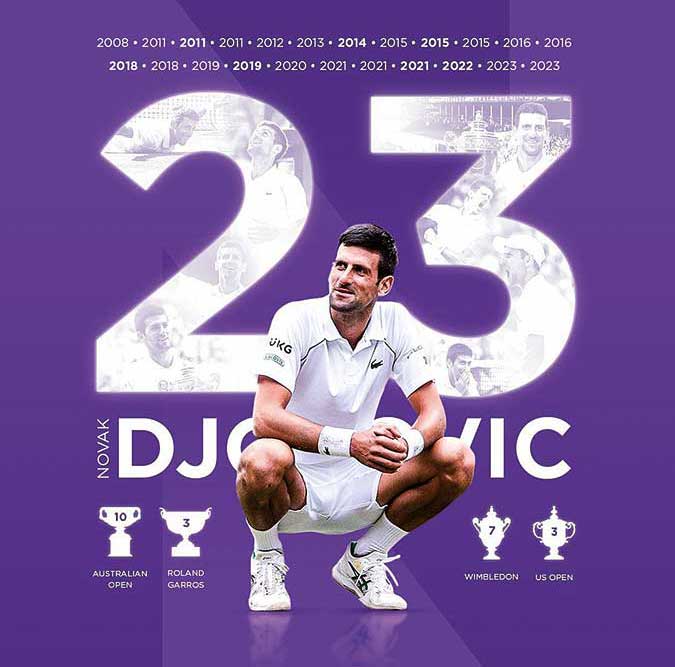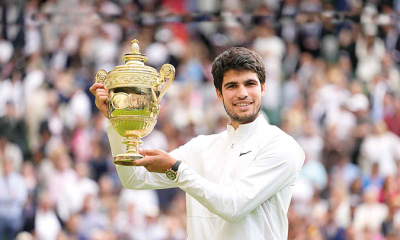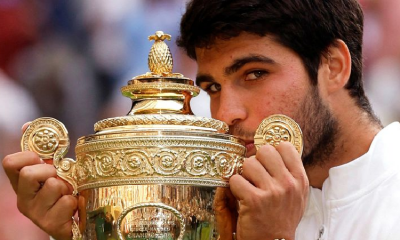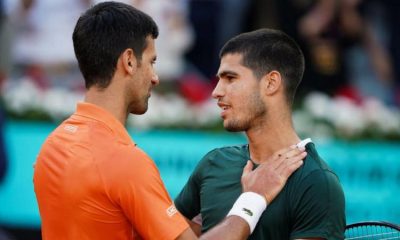Features
A Look Back on Djokovic’s French Open

by Vijaya Chandrasoma
I watched the final of the French Open a couple of Sundays ago, and was enthralled to see current World No. 1 Novak Djokovic beat the gallant Dane, Caspar Ruud, runner-up at this event last year, in straight sets to claim his 23rd Major title, a record which now can only be broken by himself.
In an era where we have been lucky to enjoy the effortless grace of Federer and the indefatigable courage of Nadal, the consummate superiority of a complete tennis player was on display at Roland Garros.
Perhaps he – and no one – will excel the grace and charm of Federer’s game. Perhaps no one will ever parallel the sportsmanship of Stefan Edberg, the Swede who won six Grand Slam men’s singles, two each of Wimbledon, Australian and US Open titles, in the 1980s and 90s. Being a quintessential serve and volley player, the red clay of Roland Garros did not suit his type of game.
It’s entirely possible that Carlos Alcaraz, who was beaten by Djokovic in the semi-finals, will fulfill the incredible talent he has already shown and break all records, one day in the future.
Much has been made of the long bathroom break Djokovic took after the second set of the semi-final, when Carlito was showing signs of distress caused by cramp. A break that many implied that Djokovic used as a means to further upset the rhythm of an injured man. Be that as it may, physical condition is an essential part of the game, so surely a 20-year-old should not be suffering from cramps after two hard sets, when a 36-year-old looked supremely fit to continue.
As Djokovic himself said, “I don’t want to say I am the greatest….because I feel it is disrespectful towards all the great champions in different eras of our sport that was played in a completely different way than it is played today. So I feel each great champion of his own generation has left a huge mark, a legacy, and paved the way for us to be able to play this sport in such a great stage worldwide”.
A statement of grace and humility, from a man for whom the best may well be yet to come. As lead coach Goran Ivanisevic, himself a Wimbledon Champion in the 1990s, said: “Novak has in his body has many more slams”.
His main rival, Carlos Alcaraz, the World’s No.1 till Djokovic beat him in a semi-final marred by injury, was magnanimous in his defeat:
“Many people want to create controversy about Novak’s bathroom break. But no, I don’t believe it influenced anything. The physical demands Novak placed on me (in the first two sets) had an impact. Ultimately, I couldn’t hold on physically. And I don’t blame him for closing the match.
“It’s not easy to play against Novak, you know. Of course a legend in our sport. If someone says that he gets into the court with no nerves playing against Novak, he lies”.
For me, for now, Novak Djokovic reigns supreme, the world’s complete tennis player. Until Wimbledon in a couple of weeks.
I have been following tennis since the 1950s, the days of Pancho Gonzales and Frank Sedgman, great players who were not able to compete in the Grand Slam events because they were professionals, ordinary human beings who had to earn a living, usually by coaching and exhibition matches. I had the great good fortune to attend such an exhibition match in 1959 at the Wembley Stadium in London, when Segura and Sedgman played Gonzales and Trabert. I was dazzled by their wonderful tennis, although they were mainly kidding around. I still remember Pancho Segura placing a half-crown coin where the center service line meets the service line(I hope I’ve got that right), and Pancho Gonzales, who had a wonderful serve, sent the coin flying every time.
In those days, no prize money was awarded for the qualified amateurs, who were reimbursed for their travel expenses only.
The tennis scene has changed beyond recognition since the advent of the Open Era in 1968, when all players, amateur and professional, were allowed to play in the four Grand Slam events, Wimbledon, the US Open, Roland Garros and Australia.
The prize money for these Grand Slam events has now reached staggering levels. When Rod Laver beat Tony Roche to win the first Open Wimbledon title in 1968, he was paid a mere 2,000 pounds sterling, which in today’s US dollars amount to approximately $25,000.
The total French Open prize money in 2023 was 43.9 million Euros (US$47 million), with the winners of the men’s and women’s singles titles, Novak Djokovic and Iga Swiatek, taking home princely purses of 2.3 million Euros (US$ 2.46 million) each. Even a first-round loser was paid 69,000 Euros (US$ 74,000).
In the late 1950s, I was a student in London. I never saw the French Open live, but was a regular at Wimbledon, originally and grandly named the All-England Lawn Tennis and Croquet Club. The total cost of a day at Wimbledon during the tournament – travel to Wimbledon by tube, a ticket to watch the tennis in many courts, with a British snack best described as substantial but tasteless, cost under a couple of pounds – Rs. 30, well within the budget of Ceylonese students in London. We were allowed a lavish monthly allowance of 45 pounds – Rs. 650 – by the Exchange Controller, an amount more than sufficient for us to lead most comfortable lives in England.
The only match at Wimbledon I remember to this day is one in which Nicola Pietrangeli of Italy and India’s Ramanathan Krishnan, both touch players, were pitted against each other in one of the early rounds in the late 1950s. Wonderful tennis of elegance and nuance, touch shots and finesse I enjoyed at courtside, a match forever etched in my mind. I cannot remember who won, which is hardly surprising, as, using the modern technology of today, I learnt that these two wonderful players had never competed against each other at Wimbledon.
Which goes to prove the old adage: the older we are, the better we – and our memories – were! Ah, how well-timed were our cover drives, how accurate our backhand volleys, how much prettier were the girls who reluctantly agreed to date us. Selective amnesia is a wonderful feature of one’s memory.
At school, I was an above-average tennis player, who, with an exceptionally talented partner, won the junior doubles title for Royal at the Public Schools Championships in 1956. I was a member of the tennis team at Christ Church, during my brief career at Oxford. We played against many colleges in Oxford and Cambridge, but the only match I remember was the Christ Church encounter against the OULTC (Oxford University Ladies Tennis Club). We were thrashed by some very fine lady players, but more than compensated in making new and attractive friends.
On my return from England, I continued playing club tennis on a regular basis, most often at the then exclusive, mainly white, Queen’s Club where, in those bad old days, natives had to be “invited” to join. Inevitably, I incurred the wrath of my paradoxically proud Ceylonese though Anglophile father, by accepting this invitation. I participated in many of the Club’s tennis tournaments, the highlight being a win in the Club Men’s Singles final, where I beat an Englishman, a Cambridge Blue, no less.
National Champion at the time, P.S. Kumara, also a club member, swears that I had begged of him not to enter the aforementioned event. This was an extremely insignificant title in his eyes, and being an old friend, he complied with my plea. But he went on to spread a scurrilous rumor that not only had I persuaded him not to participate, but, in my capacity as tennis convenor of the Club, I had “nobbled” the draw to ease my path to the final. Again, due perhaps to the above-mentioned selective amnesia, I remember only my win, and nothing of my friend Kum’s concocted calumny.
I also loved to travel to the “outstation” clubs, like Bandarawela, Talawakelle, Dixon’s Corner and so many others, where the members, mainly planters (and more likely, their most attractive wives), organized wonderful weekend tennis tournaments. The hospitality of our hosts was boundless, the dances they organized on the Saturdays of the tournament, entirely on British lines, beyond enjoyable. I well remember such an event in Udapusselawa, where, after the dance ended around 5 a.m., our planter host treated us to a breakfast of kippers and onions at his home, a meal I hadn’t enjoyed since my student days in London. After which, as I had qualified to play the later rounds, I was expected back at the club courts at 10.m., seriously hung over and miserable. But the hair of the dog* usually did the trick.
My greatest achievement in tennis was at Ratnapura. The late Bernard Pinto, also a National Tennis Champion in his day, paid me the honor of inviting me to play the men’s doubles with him at the club tournament in his hometown. Thanks to Bernard’s consummate skills (he instructed me to retreat into the sidelines after I served and hopefully returned serve), and leave the rest to him. We (really Bernard alone, for the most part) won the final with ease, but I had the last laugh when I persuaded the announcer at the awards ceremony to call the results thus: “Chandrasoma and partner win the men’s doubles 6/2, 6/2.”
I will try to make up for indulging myself writing about a sport I love (rather than my regular rants about the man I loathe) by presuming to provide the reader with some information about the French Open. Specifically, the origins of the naming of France’s premier tournament after Roland Garros, a French World War I hero. And the story behind the widely displayed phrase in the stadium “Victory belongs only to the most Tenacious”.
Officially named ‘Internationaux de France de Tennis’, the French now use the name Roland-Garros in all languages for the French Open.
In 1927, for the first time in history, the French beat the United States in the Davis Cup. To celebrate this monumental win, the French built a new, 20-court stadium in Paris in 1928. The French decided to name their new stadium after Roland Garros, a pioneer of military aviation and the nation’s most highly decorated, fighter pilot in WW I. He was tragically shot down by the Germans in 1918. He left a legacy of intelligence, bravery and honor, traits the French Open looks to emulate.
The phrase “Victory belongs only to the Persevering”, which is displayed prominently in the stadium, is a quote attributed to Napoleon I, which Roland Garros made his own … “so much so that he inscribed it on his planes’ propellers”. The French considered it a statement of admiration for the quality of tenacity, the attribute expected of all those who participate in the French Open, the Roland Garros tournament.
*Hair of the dog. This phrase is drawn from an ancient cure for a wound caused by a rabid dog bite. A clump of hair from the same rabid dog was placed on the wound, hopefully resulting in relief. Similarly, when suffering from a hangover caused by excessive consumption of alcohol, the ingestion of a small amount of alcohol is supposed to provide relief from the original cause of the malaise.
Features
The heart-friendly health minister

by Dr Gotabhya Ranasinghe
Senior Consultant Cardiologist
National Hospital Sri Lanka
When we sought a meeting with Hon Dr. Ramesh Pathirana, Minister of Health, he graciously cleared his busy schedule to accommodate us. Renowned for his attentive listening and deep understanding, Minister Pathirana is dedicated to advancing the health sector. His openness and transparency exemplify the qualities of an exemplary politician and minister.
Dr. Palitha Mahipala, the current Health Secretary, demonstrates both commendable enthusiasm and unwavering support. This combination of attributes makes him a highly compatible colleague for the esteemed Minister of Health.
Our discussion centered on a project that has been in the works for the past 30 years, one that no other minister had managed to advance.
Minister Pathirana, however, recognized the project’s significance and its potential to revolutionize care for heart patients.
The project involves the construction of a state-of-the-art facility at the premises of the National Hospital Colombo. The project’s location within the premises of the National Hospital underscores its importance and relevance to the healthcare infrastructure of the nation.
This facility will include a cardiology building and a tertiary care center, equipped with the latest technology to handle and treat all types of heart-related conditions and surgeries.
Securing funding was a major milestone for this initiative. Minister Pathirana successfully obtained approval for a $40 billion loan from the Asian Development Bank. With the funding in place, the foundation stone is scheduled to be laid in September this year, and construction will begin in January 2025.
This project guarantees a consistent and uninterrupted supply of stents and related medications for heart patients. As a result, patients will have timely access to essential medical supplies during their treatment and recovery. By securing these critical resources, the project aims to enhance patient outcomes, minimize treatment delays, and maintain the highest standards of cardiac care.
Upon its fruition, this monumental building will serve as a beacon of hope and healing, symbolizing the unwavering dedication to improving patient outcomes and fostering a healthier society.We anticipate a future marked by significant progress and positive outcomes in Sri Lanka’s cardiovascular treatment landscape within the foreseeable timeframe.
Features
A LOVING TRIBUTE TO JESUIT FR. ALOYSIUS PIERIS ON HIS 90th BIRTHDAY

by Fr. Emmanuel Fernando, OMI
Jesuit Fr. Aloysius Pieris (affectionately called Fr. Aloy) celebrated his 90th birthday on April 9, 2024 and I, as the editor of our Oblate Journal, THE MISSIONARY OBLATE had gone to press by that time. Immediately I decided to publish an article, appreciating the untiring selfless services he continues to offer for inter-Faith dialogue, the renewal of the Catholic Church, his concern for the poor and the suffering Sri Lankan masses and to me, the present writer.
It was in 1988, when I was appointed Director of the Oblate Scholastics at Ampitiya by the then Oblate Provincial Fr. Anselm Silva, that I came to know Fr. Aloy more closely. Knowing well his expertise in matters spiritual, theological, Indological and pastoral, and with the collaborative spirit of my companion-formators, our Oblate Scholastics were sent to Tulana, the Research and Encounter Centre, Kelaniya, of which he is the Founder-Director, for ‘exposure-programmes’ on matters spiritual, biblical, theological and pastoral. Some of these dimensions according to my view and that of my companion-formators, were not available at the National Seminary, Ampitiya.
Ever since that time, our Oblate formators/ accompaniers at the Oblate Scholasticate, Ampitiya , have continued to send our Oblate Scholastics to Tulana Centre for deepening their insights and convictions regarding matters needed to serve the people in today’s context. Fr. Aloy also had tried very enthusiastically with the Oblate team headed by Frs. Oswald Firth and Clement Waidyasekara to begin a Theologate, directed by the Religious Congregations in Sri Lanka, for the contextual formation/ accompaniment of their members. It should very well be a desired goal of the Leaders / Provincials of the Religious Congregations.
Besides being a formator/accompanier at the Oblate Scholasticate, I was entrusted also with the task of editing and publishing our Oblate journal, ‘The Missionary Oblate’. To maintain the quality of the journal I continue to depend on Fr. Aloy for his thought-provoking and stimulating articles on Biblical Spirituality, Biblical Theology and Ecclesiology. I am very grateful to him for his generous assistance. Of late, his writings on renewal of the Church, initiated by Pope St. John XX111 and continued by Pope Francis through the Synodal path, published in our Oblate journal, enable our readers to focus their attention also on the needed renewal in the Catholic Church in Sri Lanka. Fr. Aloy appreciated very much the Synodal path adopted by the Jesuit Pope Francis for the renewal of the Church, rooted very much on prayerful discernment. In my Religious and presbyteral life, Fr.Aloy continues to be my spiritual animator / guide and ongoing formator / acccompanier.
Fr. Aloysius Pieris, BA Hons (Lond), LPh (SHC, India), STL (PFT, Naples), PhD (SLU/VC), ThD (Tilburg), D.Ltt (KU), has been one of the eminent Asian theologians well recognized internationally and one who has lectured and held visiting chairs in many universities both in the West and in the East. Many members of Religious Congregations from Asian countries have benefited from his lectures and guidance in the East Asian Pastoral Institute (EAPI) in Manila, Philippines. He had been a Theologian consulted by the Federation of Asian Bishops’ Conferences for many years. During his professorship at the Gregorian University in Rome, he was called to be a member of a special group of advisers on other religions consulted by Pope Paul VI.
Fr. Aloy is the author of more than 30 books and well over 500 Research Papers. Some of his books and articles have been translated and published in several countries. Among those books, one can find the following: 1) The Genesis of an Asian Theology of Liberation (An Autobiographical Excursus on the Art of Theologising in Asia, 2) An Asian Theology of Liberation, 3) Providential Timeliness of Vatican 11 (a long-overdue halt to a scandalous millennium, 4) Give Vatican 11 a chance, 5) Leadership in the Church, 6) Relishing our faith in working for justice (Themes for study and discussion), 7) A Message meant mainly, not exclusively for Jesuits (Background information necessary for helping Francis renew the Church), 8) Lent in Lanka (Reflections and Resolutions, 9) Love meets wisdom (A Christian Experience of Buddhism, 10) Fire and Water 11) God’s Reign for God’s poor, 12) Our Unhiddden Agenda (How we Jesuits work, pray and form our men). He is also the Editor of two journals, Vagdevi, Journal of Religious Reflection and Dialogue, New Series.
Fr. Aloy has a BA in Pali and Sanskrit from the University of London and a Ph.D in Buddhist Philosophy from the University of Sri Lankan, Vidyodaya Campus. On Nov. 23, 2019, he was awarded the prestigious honorary Doctorate of Literature (D.Litt) by the Chancellor of the University of Kelaniya, the Most Venerable Welamitiyawe Dharmakirthi Sri Kusala Dhamma Thera.
Fr. Aloy continues to be a promoter of Gospel values and virtues. Justice as a constitutive dimension of love and social concern for the downtrodden masses are very much noted in his life and work. He had very much appreciated the commitment of the late Fr. Joseph (Joe) Fernando, the National Director of the Social and Economic Centre (SEDEC) for the poor.
In Sri Lanka, a few religious Congregations – the Good Shepherd Sisters, the Christian Brothers, the Marist Brothers and the Oblates – have invited him to animate their members especially during their Provincial Congresses, Chapters and International Conferences. The mainline Christian Churches also have sought his advice and followed his seminars. I, for one, regret very much, that the Sri Lankan authorities of the Catholic Church –today’s Hierarchy—- have not sought Fr.
Aloy’s expertise for the renewal of the Catholic Church in Sri Lanka and thus have not benefited from the immense store of wisdom and insight that he can offer to our local Church while the Sri Lankan bishops who governed the Catholic church in the immediate aftermath of the Second Vatican Council (Edmund Fernando OMI, Anthony de Saram, Leo Nanayakkara OSB, Frank Marcus Fernando, Paul Perera,) visited him and consulted him on many matters. Among the Tamil Bishops, Bishop Rayappu Joseph was keeping close contact with him and Bishop J. Deogupillai hosted him and his team visiting him after the horrible Black July massacre of Tamils.
Features
A fairy tale, success or debacle

Sri Lanka-Singapore Free Trade Agreement
By Gomi Senadhira
senadhiragomi@gmail.com
“You might tell fairy tales, but the progress of a country cannot be achieved through such narratives. A country cannot be developed by making false promises. The country moved backward because of the electoral promises made by political parties throughout time. We have witnessed that the ultimate result of this is the country becoming bankrupt. Unfortunately, many segments of the population have not come to realize this yet.” – President Ranil Wickremesinghe, 2024 Budget speech
Any Sri Lankan would agree with the above words of President Wickremesinghe on the false promises our politicians and officials make and the fairy tales they narrate which bankrupted this country. So, to understand this, let’s look at one such fairy tale with lots of false promises; Ranil Wickremesinghe’s greatest achievement in the area of international trade and investment promotion during the Yahapalana period, Sri Lanka-Singapore Free Trade Agreement (SLSFTA).
It is appropriate and timely to do it now as Finance Minister Wickremesinghe has just presented to parliament a bill on the National Policy on Economic Transformation which includes the establishment of an Office for International Trade and the Sri Lanka Institute of Economics and International Trade.
Was SLSFTA a “Cleverly negotiated Free Trade Agreement” as stated by the (former) Minister of Development Strategies and International Trade Malik Samarawickrama during the Parliamentary Debate on the SLSFTA in July 2018, or a colossal blunder covered up with lies, false promises, and fairy tales? After SLSFTA was signed there were a number of fairy tales published on this agreement by the Ministry of Development Strategies and International, Institute of Policy Studies, and others.
However, for this article, I would like to limit my comments to the speech by Minister Samarawickrama during the Parliamentary Debate, and the two most important areas in the agreement which were covered up with lies, fairy tales, and false promises, namely: revenue loss for Sri Lanka and Investment from Singapore. On the other important area, “Waste products dumping” I do not want to comment here as I have written extensively on the issue.
1. The revenue loss
During the Parliamentary Debate in July 2018, Minister Samarawickrama stated “…. let me reiterate that this FTA with Singapore has been very cleverly negotiated by us…. The liberalisation programme under this FTA has been carefully designed to have the least impact on domestic industry and revenue collection. We have included all revenue sensitive items in the negative list of items which will not be subject to removal of tariff. Therefore, 97.8% revenue from Customs duty is protected. Our tariff liberalisation will take place over a period of 12-15 years! In fact, the revenue earned through tariffs on goods imported from Singapore last year was Rs. 35 billion.
The revenue loss for over the next 15 years due to the FTA is only Rs. 733 million– which when annualised, on average, is just Rs. 51 million. That is just 0.14% per year! So anyone who claims the Singapore FTA causes revenue loss to the Government cannot do basic arithmetic! Mr. Speaker, in conclusion, I call on my fellow members of this House – don’t mislead the public with baseless criticism that is not grounded in facts. Don’t look at petty politics and use these issues for your own political survival.”
I was surprised to read the minister’s speech because an article published in January 2018 in “The Straits Times“, based on information released by the Singaporean Negotiators stated, “…. With the FTA, tariff savings for Singapore exports are estimated to hit $10 million annually“.
As the annual tariff savings (that is the revenue loss for Sri Lanka) calculated by the Singaporean Negotiators, Singaporean $ 10 million (Sri Lankan rupees 1,200 million in 2018) was way above the rupees’ 733 million revenue loss for 15 years estimated by the Sri Lankan negotiators, it was clear to any observer that one of the parties to the agreement had not done the basic arithmetic!
Six years later, according to a report published by “The Morning” newspaper, speaking at the Committee on Public Finance (COPF) on 7th May 2024, Mr Samarawickrama’s chief trade negotiator K.J. Weerasinghehad had admitted “…. that forecasted revenue loss for the Government of Sri Lanka through the Singapore FTA is Rs. 450 million in 2023 and Rs. 1.3 billion in 2024.”
If these numbers are correct, as tariff liberalisation under the SLSFTA has just started, we will pass Rs 2 billion very soon. Then, the question is how Sri Lanka’s trade negotiators made such a colossal blunder. Didn’t they do their basic arithmetic? If they didn’t know how to do basic arithmetic they should have at least done their basic readings. For example, the headline of the article published in The Straits Times in January 2018 was “Singapore, Sri Lanka sign FTA, annual savings of $10m expected”.
Anyway, as Sri Lanka’s chief negotiator reiterated at the COPF meeting that “…. since 99% of the tariffs in Singapore have zero rates of duty, Sri Lanka has agreed on 80% tariff liberalisation over a period of 15 years while expecting Singapore investments to address the imbalance in trade,” let’s turn towards investment.
Investment from Singapore
In July 2018, speaking during the Parliamentary Debate on the FTA this is what Minister Malik Samarawickrama stated on investment from Singapore, “Already, thanks to this FTA, in just the past two-and-a-half months since the agreement came into effect we have received a proposal from Singapore for investment amounting to $ 14.8 billion in an oil refinery for export of petroleum products. In addition, we have proposals for a steel manufacturing plant for exports ($ 1 billion investment), flour milling plant ($ 50 million), sugar refinery ($ 200 million). This adds up to more than $ 16.05 billion in the pipeline on these projects alone.
And all of these projects will create thousands of more jobs for our people. In principle approval has already been granted by the BOI and the investors are awaiting the release of land the environmental approvals to commence the project.
I request the Opposition and those with vested interests to change their narrow-minded thinking and join us to develop our country. We must always look at what is best for the whole community, not just the few who may oppose. We owe it to our people to courageously take decisions that will change their lives for the better.”
According to the media report I quoted earlier, speaking at the Committee on Public Finance (COPF) Chief Negotiator Weerasinghe has admitted that Sri Lanka was not happy with overall Singapore investments that have come in the past few years in return for the trade liberalisation under the Singapore-Sri Lanka Free Trade Agreement. He has added that between 2021 and 2023 the total investment from Singapore had been around $162 million!
What happened to those projects worth $16 billion negotiated, thanks to the SLSFTA, in just the two-and-a-half months after the agreement came into effect and approved by the BOI? I do not know about the steel manufacturing plant for exports ($ 1 billion investment), flour milling plant ($ 50 million) and sugar refinery ($ 200 million).
However, story of the multibillion-dollar investment in the Petroleum Refinery unfolded in a manner that would qualify it as the best fairy tale with false promises presented by our politicians and the officials, prior to 2019 elections.
Though many Sri Lankans got to know, through the media which repeatedly highlighted a plethora of issues surrounding the project and the questionable credentials of the Singaporean investor, the construction work on the Mirrijiwela Oil Refinery along with the cement factory began on the24th of March 2019 with a bang and Minister Ranil Wickremesinghe and his ministers along with the foreign and local dignitaries laid the foundation stones.
That was few months before the 2019 Presidential elections. Inaugurating the construction work Prime Minister Ranil Wickremesinghe said the projects will create thousands of job opportunities in the area and surrounding districts.
The oil refinery, which was to be built over 200 acres of land, with the capacity to refine 200,000 barrels of crude oil per day, was to generate US$7 billion of exports and create 1,500 direct and 3,000 indirect jobs. The construction of the refinery was to be completed in 44 months. Four years later, in August 2023 the Cabinet of Ministers approved the proposal presented by President Ranil Wickremesinghe to cancel the agreement with the investors of the refinery as the project has not been implemented! Can they explain to the country how much money was wasted to produce that fairy tale?
It is obvious that the President, ministers, and officials had made huge blunders and had deliberately misled the public and the parliament on the revenue loss and potential investment from SLSFTA with fairy tales and false promises.
As the president himself said, a country cannot be developed by making false promises or with fairy tales and these false promises and fairy tales had bankrupted the country. “Unfortunately, many segments of the population have not come to realize this yet”.
(The writer, a specialist and an activist on trade and development issues . )
























